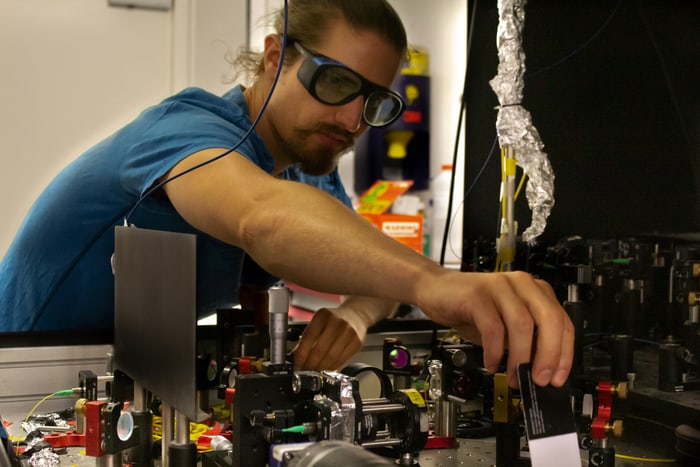
When two particles are levitated in the focus of a laser beam, light reflects back and forth between them to form standing waves. The interaction with these standing waves causes the particles to self-align in a phenomenon known as optical binding. Now, for the first time, researchers at the University of Vienna, the Austrian Academy of Sciences and the University of Duisburg-Essen, Germany have succeeded in fully controlling this binding between two optically levitated nanoparticles in parallel laser beams. The achievement provides a new platform for exploring collective quantum dynamics with two or more particles.
In the work, the researchers showed that by tuning the properties of the laser beam, they could control not only the strength of the interaction between particles, but also whether this interaction was attractive, repulsive or even non-reciprocal. “Non-reciprocal means that one particle pushes the other but the other one doesn’t push back,” explains team member Benjamin Stickler of the University of Duisburg-Essen. “While this behaviour seemingly violates Newton’s third law in a system that looks quite symmetric, it doesn’t because some momentum is carried away by the light field.”
Coherent scattering
Previous studies of optically-bound particles had not described this non-reciprocal behaviour, but the team say that it stems from a phenomenon known as coherent scattering. Essentially, when laser light impinges on a nanoparticle, the nanoparticle becomes polarized so that it follows the oscillations of the light’s electromagnetic waves.
“As a consequence, all light that is scattered from the particle oscillates in phase with the incoming laser,” explains team member Uros Delic of the University of Vienna. “Light that is scattered from one particle can interfere with the light that traps the other particle. If the phase between these light fields can be tuned, so can the strength and character of the forces between the particles.”
To tease out this behaviour, team members in Vienna set up two parallel optical tweezers with a spatial light modulator, which is a liquid crystal display that can split or shape the laser beam. “The particles are initially trapped close to each other to see how they interact via the light that bounces off them – that is, how they optically bind,” explains Delic. “The way to do that is to observe how their oscillation frequencies as we put them close: the more they change, the stronger the interaction.”
Thanks to theoretical calculations by their colleagues in Duisburg, the researchers found that the interactions can become non-reciprocal for a specific setting. This finding was confirmed by observations in the laboratory, where it turned out the interaction between the particles was more complex than anticipated.
“A radically new tool”
“Our experiment provides a radically new tool for controlling and exploring the interactions between levitated nanobjects,” Delic and Stickler tell Physics World. “The level of achieved control and operation in the quantum regime opens up many interesting research avenues, for example studying complex phenomena in multiparticle systems.”

Optical tweezers hold nanoparticles in superfluid helium
The researchers say they will now try to scale up their technique so that it can be extended to many levitated nanoparticles. “The tuneable interactions will allow us to program connections between particles and explore how they collectively move and form patterns,” Delic and Stickler say.
The present study is published in Science.
